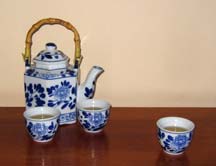Oriental Herbal Teas

Ginger Tea
Ginger is one of the most common herbs used in Chinese herbology. It has a warming
effect, stimulates poor appetite, and helps circulation. It is especially useful
for patients whose chi is deficient and needs warming and building. Ginger can
be included regularly in cooking as well as made into a tasty tea.
To make ginger, tea take some fresh ginger root and cut into thin slices.
Put into a pan of water, bring to a boil and then simmer for five minutes.
Drinking this tea can be especially good if you get chilled, or if you start
to come down with a cold. Organic fresh ginger can be purchased at any health
food store.
Cinnamon Twig Tea
Cinnamon is another herb that is used extensively in Chinese herbology. Like
ginger, it is warming and in traditional Chinese texts is described as helping
to strengthen the defensive chi. It also warms and improves circulation of
the chi, especially the limbs and shoulders. Traditionally the twig, rather
than the bark, of the cinnamon tree is used to make tea. To make the tea,
add 2-3 tablespoons of the twigs to 3 cups of water. Bring to boil and then
simmer for five minutes. Honey can be added to make the tea sweeter. This
tea is available at our office.
Green Tea
Green tea has been drunk in China, Korea, and Japan and other Oriental countries
for many thousands of years. Unlike Kukicha and Cinnamon tea, it is classified
in Chinese herbology as being cool. It has a very small amount of caffeine
in it, so it does have a slightly stimulating effect. Traditionally it is
described as increasing the circulation of chi. It is also used to help alleviate
constipation, fever and headaches. Studies of green tea also suggest it is
helpful in preventing strokes, as well as stomach and pancreatic cancer.
Kukicha Tea
Kukicha tea is made from the roasted stems of the green tea plant. Its taste
is mild, yet substantial and satisfying. It contains only traces of caffeine,
unlike green bancha tea or ordinary tea which has much higher caffeine content.
Kukicha tea can be bought either at our office or at health food stores.
To make the tea, add 1-2 teaspoons to each cup of water and simmer between
three to ten minutes. The longer you simmer the tea, the stronger it will become.
The twigs can be re-used 2 or 3 times, just add a little more water and a few
fresh twigs.
This tea is very good for relieving fatigue. It is also a good antidote for
sweets, because is acts as a buffer and it neutralizes an over-acid stomach.
For Cold and Flu Symptoms
There are two ways that Kukicha tea can help combat an oncoming cold or flu.
One way is to mix 1 teaspoon of tamari soya sauce with hot tea. Another,
stronger, way is to add an umaboshi plum to the tea and tamari. Adding the
tamari and plum makes the tea more alkaline. Both drinks can be taken one
or three times a day for up to 3 days. These drinks can be taken along with
Chinese herbs such as Yin Chiao or Isatis 6 and Forsythia 18 to support the
functioning of the immune system.
Other articles concerning diet:
|